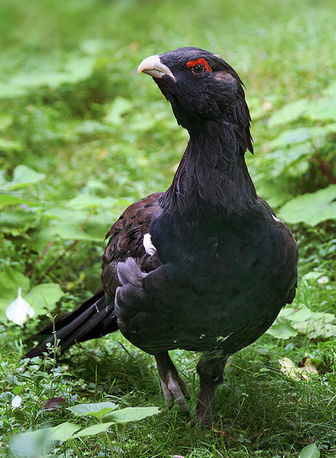Eurasian Capercaillie
Also spelt Capercailzie , this species' name is derived from the Gaelic capull coille, meaning horse of the woods.

Original source: Own work
Author: Richard Bartz, Munich aka Makro Freak Permission(Reusing this file) This file is licensed under the Creative Commons Attribution-Share Alike 2.5 Generic license.You are free:to share – to copy, distribute and transmit the work
The Eurasian Capercaillie is classified as Least Concern. Does not qualify for a more at risk category. Widespread and abundant taxa are included in this category.
Eurasian Capercaillie (松雞) ; Woodchat Shrike (林鶺伯勞) Firecrest (火冠戴菊) Switzerland (1968) 14th July, 2009. Bern (Philatelic Bureau) Each year, Swiss Post issues a set of children fund charity stamps on its final season. Mostly stamps are related to children like different faces of child, folk stories, tales or toys. In 1968 to 1971, there were four issues illustrated 16 domestic birds, the above cover with three block of four were issued on 1968. More
Eurasian Capercaillie (Tetrao urogallus), was known to produce ultra-low sounds. According to researchers working in Papua New Guinea we should add cassowaries (Genus: Casuarius spp.) to this list. Sound recordings of Dwarf (CC bennetti) and Southern Cassowaries (C. casuarius) reveal that the booming calls of both species contain sound energy in very low frequencies-23 Hz and 32 Hz, respectively. Given the thick understorey habitat occupied by cassowaries, the authors suggested that these ultra-low frequencies are used as long-distance signals. More

Permission: Some rights reserved
Family : Phasianidae
Genus : Tetrao
Species : urogallus
Authority : Linnaeus, 1758
